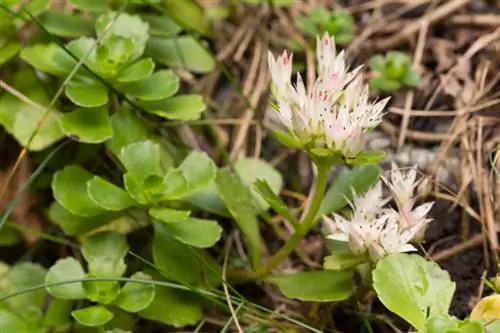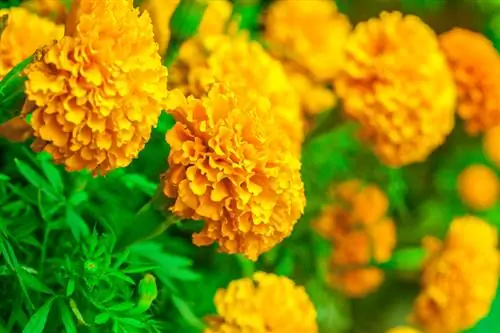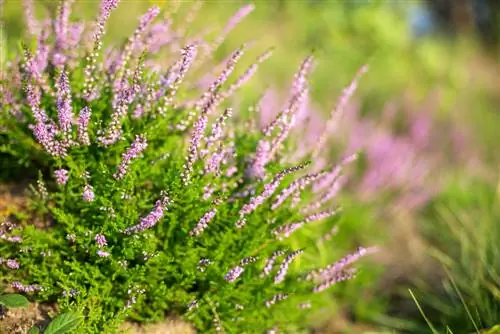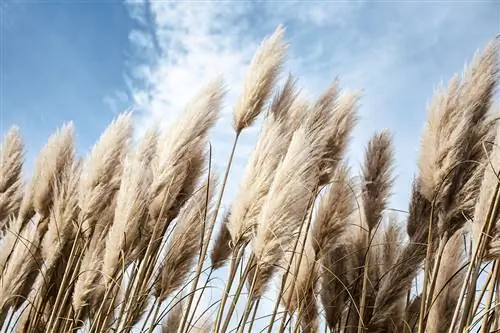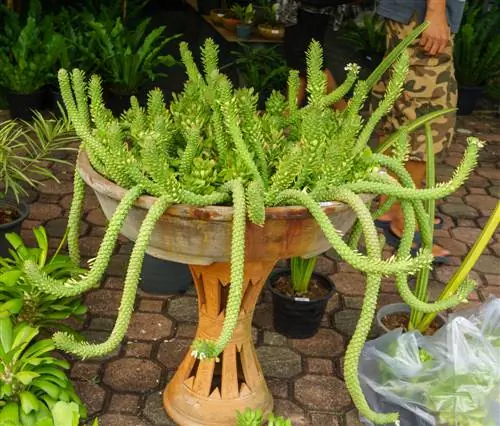- Author admin [email protected].
- Public 2023-12-25 17:45.
- Last modified 2025-01-23 11:21.
Dieffenbachias are popular foliage plants because of their large, attractively structured frond leaves. And like some other tropical plants, it can be cultivated in our room all year round with relative ease.
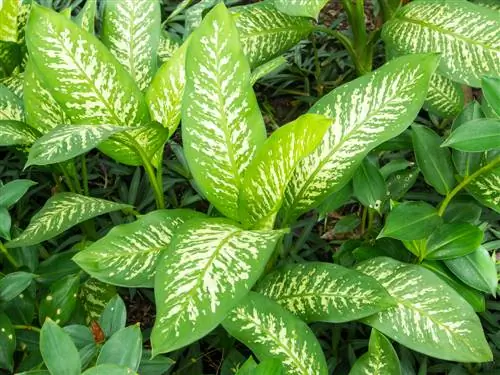
How do you properly care for a Dieffenbachia?
The Dieffenbachia, a tropical houseplant, requires a warm location (21-30°C), high humidity, no direct sunlight and evenly moist soil. It is highly poisonous and should be kept away from small children and pets. Regular watering, fertilizing and repotting promotes their growth.
Origin
Dieffenbachias originally come from the so-called Neotropics, an area that extends across large parts of South and Central America as well as the West Indies. The different Dieffenbachia species are mainly found between Costa Rica and Colombia. Their original habitat is tropical, warm and humid, which of course makes outdoor cultivation impossible in our latitudes. However, dieffenbachias cope well with being kept in a pot in a heated room all year round.
The plant genus takes its name from Joseph Dieffenbach, the long-time head gardener of the Vienna Imperial Palace Gardens Schönbrunn. With this, the Austrian botanist Heinrich Wilhelm Schott created a grateful memorial to him.
The key data at a glance:
- Dieffenbachia come from South and Central America
- original habitat i.e. tropical-humid warm
- well suited for year-round indoor cultivation
- named after the Austrian imperial gardener Joseph Dieffenbach
Growth
Dieffenbachias belong to the arum family, grow as evergreen perennials and take on a shrubby shape. They have a thick stem, which, when the plant grows outdoors, can also easily lie down due to the large, heavy leaves. The stem remains unbranched, so the leaves attach directly to it, but due to their large shape they still form an impressive overall volume.
leaves
The leaves of the Dieffenbachia, as already emphasized at the beginning, are the most important part of the plant from an ornamental and indoor gardening perspective. They have a generous, egg-shaped to oblong-lanceolate leaf blade and are alternate on the stem.
They are particularly decorative due to the variegation that many varieties show. This can have different structures - sometimes speckled, sometimes with a flat interior pattern or even fine striped patterns in creamy white. The green base color of the leaves varies from variety to variety between rich, deep dark green to light shades of green.
The leaf characteristics of Dieffenbachia:
- alternately attached directly to the stem
- ovate to oblong-lanceolate, large leaf blades
- often very pretty variegated structures
Bloom
The flower of the Dieffenbachia is of secondary importance from an aesthetic point of view. Furthermore, it is actually rarely produced. It has a piston shape typical of the aroid family with a tightly enveloping bract, the spathe. In terms of color, both the flower spadix and the spathe do not stand out particularly, but appear in a simple light green to creamy white. The dieffenbachia costs a lot of energy to produce flowers. So if you want to keep it in the room permanently for decorative purposes, you should cut off the flower.
The most important thing about the Dieffenbachia flower:
- aesthetically rather less spectacular
- flask shape with bract typical of arum plants
- inconspicuous, light green coloring
- very strenuous for the plant, possibly cut off
read more
Which location is suitable?
According to their tropical homeland, Dieffenbachias need above all a lot of warmth. Your comfort zone is slightly above the temperature that most people find comfortable in their home - hardly anyone wants to live permanently at 26-30°C. The Dieffenbachia can also thrive at temperatures of 21°C and above - this is a good place to get together with it for a long-term shared apartment.
It is also important for the Dieffenbachia to have the highest possible humidity - after all, it comes from the rainforest. It's best to pamper them regularly with a spray shower, especially during the winter heating season. It's also a good idea to put them in the bathroom, where the humidity is higher than in the living room or bedroom. You should protect the plant from drafts as much as possible.
You should also give your Dieffenbachia plenty of light. However, like some other rainforest plants, it does not tolerate full sun well. A bright window seat is best for her, and she shouldn't be left in the dark even in winter. However, it should be a little cooler because of the inevitably less light available, around 15 to 18°C.
The location rules at a glance:
- Warm: In summer 21-30°C, in winter 15-18°C
- As high humidity as possible
- No drafts
- Lots of light, but not full sun
read more
What soil does the plant need?
Dieffenbachias do not need a particularly complicated substrate. It is best to use a peaty soil mixture to which you add some compost. To prevent waterlogging, you should add some expanded clay to the lower part.
Watering Dieffenbachia
You should water the Dieffenbachia regularly and quite a lot. The root ball must not become waterlogged, otherwise it can rot. So keep it evenly moist, but not wet. To prevent long-term damage, if the root ball has been left wet for too long, you should remove it from the pot and wrap it in newspaper until it dries. In winter there is a little less watering than in summer.
The dieffenbachia especially needs a lot of moisture from the air. So spray it every now and then with the disperser and give it the illusion of pleasantly gentle, tropical precipitation.
Remember:
- water regularly and relatively much
- Avoid waterlogging as much as possible
- spray with disperser in addition to watering
Fertilize Dieffenbachia properly
Dieffenbachia's nutrient requirements are moderate. To promote fresh, vital growth, especially with regular topiary, you can mix some liquid fertilizer into the water during the main vegetation phase - but not more often than once every two weeks. Fertilizer application will be stopped in the fall.
Cut Dieffenbachia correctly
A Dieffenbachia grown indoors can tolerate one or two radical pruning - because as it gets older, the lower part of the stem can become bald, which doesn't look nice. In spring, perhaps parallel to repotting, you can cut back a specimen that has lost many leaves in the lower part to about 10 to 20 cm. To do this, use a sharp knife and of course gloves.read more
Shorten
You can also give your Dieffenbachia a regular topiary. To do this, shorten the upper shoots above a slightly arched, sleeping eye. Here it can then sprout again in a controlled manner.read more
Repotting
The Dieffenbachia species have different growth rates - but in general they do not grow up too quickly and only need to be repotted every 2 years, and for older specimens only every 4 years. The new pot should not be disproportionately larger than the old one. Important: Due to the toxicity of the plant, wear gloves when repotting, read more
Propagate Dieffenbachia
Dieffenbachia can be propagated quite easily and in various ways.
The easiest method is to cut head or stem cuttings. A head cutting can easily be rooted in a glass of water. For trunk cuttings, cut pieces about 5 cm long from the trunk and place them with the long cut side on a soil substrate. It is best to grow them under foil in a protected, evenly moist microclimate. For both methods, the warmest possible basic temperature of at least 22°C applies.
A third method is division. These are best used when repotting is due anyway. Divide a piece of the rhizome root ball including the mature above-ground plant part and place it in its own pot. Growing works best in spring when light availability increases.
The propagation methods at a glance:
- Head cuttings with rooting in a water glass
- Stem cuttings with horizontal roots in the soil substrate
- Dividing the root ball
As with all handling of the Dieffenbachia, it is important to remember the toxicity of the plant when propagating: Be sure to wear gloves when cutting cuttings and especially when dividing roots!read more
offshoot
The best way to make cuttings to expand your Dieffenbachia collection or for gardener friends is to use cutting methods.read more
Diseases
Dieffenbachia are moderately susceptible to diseases and pests. What can most likely harm the plant are unsuitable environmental conditions and care errors, such as air that is too dry or drafty, waterlogging or full sunlight.
The following parasites in particular can occur:
- Spider mites
- Sad gnats
- Scale insects
- Mealybugs
Spider mites
In dry air, Dieffenbachia can also easily get spider mites. Fighting them also serves to correct the trigger: The best way to get rid of the parasites is with water - first simply by rinsing, then with a moist, sealed permanent climate under foil.
Sad gnats
If the Dieffenbachia is very moist, fungus gnats can be attracted, which settle in the soil substrate. If there is an infestation, you can let the pot ball dry for a short time. At the same time, you can reduce the number of fungus gnats using sticky yellow boards.
Scale insects
You should also check your Dieffenbachia regularly for scale insects. They are difficult to see with the naked eye. If the infestation is mild, you can simply wipe it off the leaves with a damp cloth or shower under a jet of water. For larger populations, a spray mixture with garlic or nettle is suitable.
Mealybugs
Mealybugs can also infest Dieffenbachia if necessary. You can easily recognize them by the woolly webs that they attach to the leaves. The best way to combat them is with a mixture of one liter of water, 15 milliliters of spirit and 15 milliliters of curd soap.read more
Brown leaves
Brown leaves usually indicate drought. If the Dieffenbachia has been dry for a long time or the air is not humid enough, you should change that quickly. Water regularly and treat the plant to a hydrating mist shower every now and then.read more
Brown spots
Brown spots on the leaves of Dieffenbachia are usually sun damage. Perhaps the plant was left in the full sun for a longer period of time? Then you should change your location. Heating air that is too dry can also lead to dry, brown spots.
Is Dieffenbachia poisonous?
One unpleasant thing about Dieffenbachia is its toxicity. And this is not insignificant. If there are small children, cats or dogs in your household, it is better to avoid the plant. Consolingly, there are some other beautiful foliage houseplants such as the golden fruit palm that are suitable alternatives.
The fact is that all parts of the Dieffenbachia contain highly toxic substances, especially alkaloids, oxalic acid, saponins and pungent substances. Just 3-4 grams of the leaves are considered a lethal dose for adults alone.
Reactions to oral ingestion are initially burning and severe, even suffocating, swelling of mucous membranes, followed by vomiting and diarrhea. The esophagus and stomach can suffer severe burns, and convulsions, impaired consciousness and paralysis can also occur.
Measures in the event of a “Dieffenbachia accident” are the administration of medical charcoal and cortisone spray against the inflammation and swelling. Above all, you should immediately alert the toxicological emergency service.
Rubber gloves should always be worn when handling the Dieffenbachia, i.e. when cutting and repotting.
To remember:
- All parts of the Dieffenbachia plant are highly poisonous
- Cultivation in the household with small children and pets is therefore taboo
- Even a dose of 3-4 g is fatal in adults
- Always wear gloves when handling
Tip
Do you work in an area where you are increasingly exposed to gasoline exhaust fumes or fumes from composite materials? Put a Dieffenbachia in your office! (As long as you can offer her suitable conditions there). Dieffenbachia are one of the particularly air-purifying plants that, in addition to carbon dioxide, also absorb benzene, formaldehyde and trichloroethene to a high degree. You can protect your he alth in the long term and, above all, reduce the risk of cancer.read more
Varieties
Most Dieffenbachia varieties are hybrids that differ little from each other in terms of care requirements.
Dieffenbachia maculata
This variety is the most common ornamental form and can be recognized by its dark, broad, cream-colored, variegated leaves about 25 cm long and with pointed leaf ends. The Dieffenbachia maculata grows to a height of around 60 cm to one meter and, with its moderate size, is very suitable for indoor cultivation.
Dieffenbachia imperialis
This species, which comes from Peru, is, as its name suggests, a particularly large one: it reaches a height of around one meter to room height and a relatively expansive width. Its leaves are characterized by a pretty speckled structure in a yellowish tone on dark green. The leaves are also quite large, up to 60 cm long and around 30 cm wide.
Dieffenbachia exotica
In contrast to Dieffenbachia imperialis, Dieffenbachia exotica is a quite small variety. Its leaves are only about 25 cm long and 10 cm wide and are oval in shape. Their variegation is quite extensive, irregularly spotted and appears in yellowish tones. With its leaf structure and compact size, it is a very attractive and recommended variety.
Dieffenbachia bowmannii
This variety is again a slightly larger one - like Dieffenbachia imperialis, its leaves can reach a length of up to 60 centimeters. They are elliptical in shape and have a deep green base color. They are decorated with a spotty variegation in light green.
Dieffenbachia bausei
Dieffenbachia bausei also has a pretty spotty structure on the leaves - but in a slightly different color combination: the basic color of the leaves here is more of a yellowish green, while the variegation is dark green. The edges of the leaves also have a dark green edge, which gives them an additional, finely defined structure. In terms of size, the leaves of Dieffenbachia bausei are slightly smaller than those of Dieffenbachia bowmannii and are lanceolate. They reach about 35 cm in length and up to 15 cm in width.


